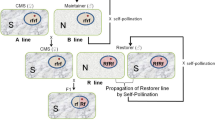Summary
Ten plants were obtained following culture of one hundred interspecific embryos derived from the cross between the wild species Cucurbita martinezii Bailey as a male and the cultivated Cucurbita pepo L., as a female parent. Immature embryos were septically (cultured) on Murashige and Skoog medium with 0.01 mg/l IAA and 0.1 mg/l KIN, which proved to be the best for squash embryo culture. Interspecific plants showed intermediate morphological characters between parents leaves and flowers. Moreover, biochemical analysis of the peroxidase isozymes as electrophoretic banding patterns showed the same intermediate trend with hybrid plants showing the majority of cultivated and wild parent bands. On the other hand, no great differences were detected between the hybrid and its parents for albumin banding patterns. Cytological studies of mitotic and meiotic chromosomes showed that hybrid root tips had the same number of chromosomes as the parents (2n=40). However mitotic chromosome karyotypes represent two main distinct groups in morphology, one from each parental species. Meiotic chromosomes of hybrids showed a high level of irregular univalent formation and low level of bivalents and chiasmata formation, supporting the conclusion that the genomes of the two species are quite different. Regarding powdery mildew and cucumber mosaic virus infectivity, both the hybrid plants and the wild parent proved to be resistant to both diseases, whereas, the cultivated parent proved to be highly susceptible.
Similar content being viewed by others
References
Beg, M.Z. and A.H. Khan (1989). Crossability and genomic relationships of some species of Solanum nigrum complex. Cytologia 54: 21–26.
Bemis, W.P.; A.M. Rhodes, T.W. Whitaker, and S.G. Carmer (1970). Numerical taxonomy applied to Cucurbita relationships. Amer. J. Bot. 57: 404–412.
Coppens, L. and D. Dewitte (1990). Esterase and peroxidase zymograms from barley (Hordeum vulgare L.) callus as a biochemical marker system of embryogenesis and organogenesis. Plant Science 67: 97–105.
De Vaulx, R.D. and M. Pitrat (1985). Interspecific cross between Cucurbita pepo and Cucurbita martinezii. Cucurbita Genetics Coop. Rpt. 8: 35.
El-Fadly, G. and E.I. Metwally (1991). Regeneration of plants from interspecific protoplast fusion between Cucumis sativus and cucumis metuliferus. 4th Nat. Conf. of pests and dis. of veg. and fruits in Egypt. pp: 607–616.
Franez, P.E.; N.C.A.De Ruijter, and J.h.N. Schel (1989). Isozymes as biochemical and cytochemical markers in embryogenic cultures of maize (Zea mays L.). Plant Cell Reports 8: 67–70.
Hamrick, J.L. (1983). The distribution of genetic variation within and among natural plant populations, pp: 335–348. In: C.M. Shonewald-Cox, S.M. Chambers, B. MacBryde and L. Thomas (eds). Genetics and Conservation. Benyamin/Cummings, Menlo Park, New Jersey.
Haroun, S.M.; A.T. Richard, and R.D. Macleod (1991). Genetic relationships between some millets (Panicum). Bot. J. Linn. Soc. 13: 259–267.
Metwally, E.I. and G. El-Fadly (1991). In vitro differentiation of the immature interspecific embryos derived from the crosses between Cucurbita pepo and Cucubrita focifolia. 4th Nat. Conf. of pests and dis. of veg. and fruits in Egypt. pp: 598–606.
Morikawa, T. (1987). Monosomic analysis of leaf peroxidase pox and px9 loci in hexaploid oats. Genome 30: 99–102.
Munger, H.M. (1976). Cucurbita martinezii as a source of disease resistance. Veg. Imp. News Letter 18: 4.
Munger, H.M. and R.L. Washek (1983). Progress and procedures in breeding CMV resistant C. pepo L. Cucurbit Genetics Coop. Rpt. 6: 82–83.
Omar, R.A.; M. El-Khadem, and S.A. El-Kewey, (1979). Three strains of cucumber mosaic virus affecting vegetable crops in A.R.E. Proc. 3th Arab Pesticide Conf., Tanta Univ., Vol. (II): 479–493.
Provvidenti, R.; R.W. Robinson, and H.M. Munger (1978). Multiple virus resistance in Cucurbita species. Cucurbit genetics Coop. Rpt. 1: 26–27.
Robinson, R.W.; J.T. Puchalski, and A.C. Ruiter (1979). Isozyme analysis of megunk. Cucurbit Genetics Coop. Rpt. 2: 17–18.
Singh, R.N. and S.K. Roy (1986). Chromosome association and pollen fertility in Solanum melongena x S. surattense hybrid. Cytologia 51: 85–93.
Stegmann, H.; W. Burgermeister; H. Franksen, and E. Krojerrecklenfort (1985). Polyacrylamide Gel Electrophoresis Manual, Ch. 3, pp. 6 and Ch. 5, pp. 1.
Van Vliet, G.J.A. and W.D. Meysing (1974). Inheritance of resistance to Pseudoperonospora cubensis Rost. in cucumber (Cucumis sativus L.). Euphytica 23: 251–255.
Varghese, B.M. (1973). Studies on the cytology and evolution of South Indian Cucurbitaceae. Ph.D. Thesis, Kerala Univ., India.
Whitaker, T.W. and W.P. Bemis (1976). Evolution of crop plants. Longman Group Limited London, 65–69.
Whitaker, T.W. and G.N. Davis (1962). Cucurbits. Botany, Cultivation and utilization. New York.
Author information
Authors and Affiliations
Rights and permissions
About this article
Cite this article
Metwally, E.I., Haroun, S.A. & El-Fadly, G.A. Interspecific cross between cucurbita pepo L. and Cucurbita martinezii through in vitro embryo culture. Euphytica 90, 1–7 (1996). https://doi.org/10.1007/BF00025153
Received:
Accepted:
Issue Date:
DOI: https://doi.org/10.1007/BF00025153




